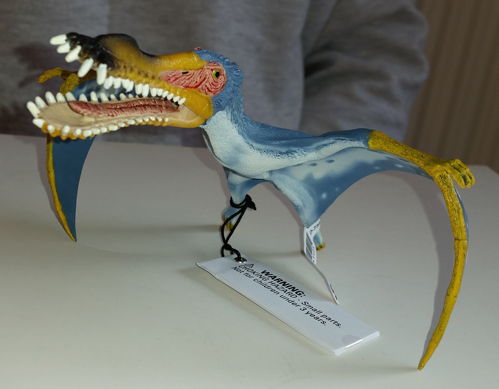The Confusion over Pterodactyls
As far as scientists have been able to ascertain from the fossil record, only a very few types of dinosaur evolved the ability of flight. Of course, technically birds, of which there are something like 10,000 species today; evolved flight and these creatures could be classified as avian dinosaurs. However, setting aside the Aves (birds) for one moment we know that the early Mesozoic skies came to be dominated by another group of reptiles – pterosaurs. Pterosaurs seem to have evolved sometime in the Middle Triassic. Over the course of the next 160 million years or so, they diversified into a myriad of different forms. Some of these creatures were no bigger than blackbirds, others, for example a group known as the Azhdarchidae; evolved into flying reptiles the size of small aircraft. However, all pterosaurs had the same basic skeleton and body plan.
A Replica of a Pterosaur

A colourful model of the pterosaur called Anhanguera by Schleich. Picture credit: Everything Dinosaur.
Picture credit: Everything Dinosaur
To view models and replicas of prehistoric animals in the Schleich model range: Schleich Dinosaurs and Prehistoric Animal Models.
Pterosaurs
Pterosaurs (flying or winged lizards) are sometimes referred to as pterodactyls (winged fingers). Pterodactyl is the name for just one particular family of pterosaurs, and in particular for a German flying reptile called Pterodactylus. Fossils of Pterodactylus were found in the 19th century and remain some of the most complete and best preserved of all pterosaur fossils. The name pterodactyl became quite well known and used a lot in popular culture and as a result the name “pterodactyl” – a term used colloquially to describe all pterosaurs became established.






So, When & why were Pterodactyl changed to pterodan?
Pterodactyl is a term popularised by the general media but not one recognised by scientists. It probably derives from the genus Pterodactylus which was named and described in the early 19th Century. Pteranodon is another genus, these types of flying reptile are assigned to the Order Pterosauria.